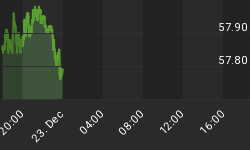Ever since the current (final wave 5?) leg in the now 4 year, 7 month old US stock bull market generated in November of 2012, NFTRH has tried to make the point that there is no new secular bull market in US stocks. Indeed, there is a maturing cyclical bull market that has another 5 (+/-) months to live if it is to match the two previous cycles. The bubble leader, Russell 2000 does after all have a measured target of 1350 (Kisses Goodbye).
Why do we call the US cyclical stock bull a bubble you ask? Because of this chart (courtesy of SlopeCharts), variations of which NFTRH subscribers have been repeatedly hit over the head with just to make sure that we know what we are dealing with.

The orange line (S&P 500) shows the first hump was the ending bubble phase of the secular bull market, when stocks just had to be owned by the public even as they separated from all rational measures of value, including corporate profits (green line). The second hump was in line with corporate profits as the Greenspan-instigated credit bubble served to pump the economy temporarily. The third hump goes hand in hand with corporate profits and with a more honest official inflation (as policy) as the Monetary Base hockey stick (blue) sees to it that corporate profits and the S&P 500 keep right on rising.
The two previous humps lasted about 5 years each. T minus...
Today's cyclical stock bull is likely a bubble because reverence toward policy makers and the efficacy of policy making is likely a bubble. Remember how well reviled Ben Bernanke was in 2011? Pitchfork wielding mobs and all? Bill Gross very publicly went bearish against long-term Treasury bonds due to the inflation that "Helicopter Ben" had promoted? "How you like me now, suckas?" thinks Ben.
The macro backdrop is currently a compressed and oh so noisy 'mini-me' version of the the big changes that occurred in 2000. The difference is secular vs. cyclical. So what does this mean for the gold stock sector?

Well for one thing it means that gold stocks are back on the counter cycle where they belong after spending 8 years (shaded area) mostly in positive correlation to the US stock market. The gold stock bull market was birthed on a counter cycle as the great secular stock bull market ended in 2000.
If symmetry holds and we are right to call the S&P 500's bull market a cyclical one with termination measured in months, not years, then we may also be right in looking for a strong rally at least and new cyclical bull market at best, in the absolutely torn to shreds gold mining sector.
If you look at the big picture chart above you see a series of higher highs and higher lows intact on the HUI during the secular phase from 2000 to present. What is a bull market? It is a series of higher highs and higher lows. The cyclical bear of the last two years has required infinite risk management but let me ask you this; how many stock market bulls are thinking about risk management right now? The same proportion that were doing so in 2000 maybe?
Conversely, how many strong gold stock bulls are left out there? The same proportion as in 2000 maybe? The current cycle has from several vantage points (macro fundamental and technical) the potential to be a mini-me version of the big changes that occurred in 2000. Best of all, few are expecting it. Next best of all, in the event this analysis is incorrect and a new, enduring era of economic plenty has actually been manufactured by policy, gold will fail again and the gold stock sector will probably fail the blue dotted line above, which can be considered a close proximity 'stop loss' to this plan.
But if the plan is correct, it is a long way up to another higher high on the HUI (though it is best to manage lower, shorter term targets and resistance points for now). Meanwhile, expect grind and noise as emotional markets play out their respective roles with policy makers front and center both in the media (jawboning) and through official policy statements (FOMC comin' at ya tomorrow at 2PM US Eastern).
Notes From the Rabbit Hole is a service (a weekly letter and interim updates/Key ETF charts at the site) that does not predict much, but does form probabilities-based plans and then rigidly follows and tests those plans every step of the way. In other words, we use market management, not swami-like predictions. It would be my distinct pleasure to welcome you to NFTRH if you would like to try a macro market service designed for the long run and all market environments.
















